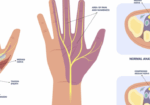1. 继续教育简介
物理和职业治疗的继续教育不仅仅是一项要求,更是职业成长的核心。在这个不断发展的领域,紧跟潮流不仅明智,而且必不可少。对于物理治疗师 (PT) 和职业治疗师 (OT) 而言,继续教育 (CE) 有助于提升技能、改善患者治疗效果并维持执照。
继续教育促进:
- 更新临床知识
- 更高的专业可信度
- 遵守许可证委员会的规定

2. 什么是物理治疗继续教育?
物理治疗继续教育包括拓展临床知识和技能的学习活动。这些活动包括:
- 在线 CEU 模块
- 手法治疗工作坊
- 高级认证(例如骨科临床专家)
PT CE 确保治疗师精通当前的治疗和康复方案。主题通常包括疼痛管理、神经康复和术后护理。
3. 什么是职业治疗继续教育?
职业治疗继续教育侧重于支持日常生活活动和功能独立性的治疗技术。职业治疗师的继续教育主题通常包括:
- 感觉统合
- 手部治疗
- 心理健康支持
- 儿科或老年科干预
它使治疗师能够应用针对各个年龄段患者需求的循证策略。
4. 州对 PT 和 OT 的持续教育要求
美国每个州都制定了自己的继续教育要求:
- 有些州要求每两年 20-30 小时
- 其他可能需要特定内容(例如伦理学或法学)
- 不满足要求可能会延迟许可证续期
通过您所在州的许可委员会随时了解情况,以避免合规问题。
5. CEU学分解释
A 继续教育单位(CEU) 通常等于 10个接触小时 教学。然而,具体数值可能因提供商和州法规而异。PT 和 OT 通常需要一定数量的 CEU 才能续签执照——通常每个周期 1.5 到 3 个 CEU。
重要提示: 请务必核实课程在您所在的州是否算作 CEU。
6. 值得信赖的认证持续教育供应商
应仅参加由值得信赖的机构认可的继续教育课程。请注意:
- 亚太旅游协会 (美国物理治疗协会)
- AOTA (美国职业治疗协会)
许多州并不要求这些机构获得认证,但它们的认证有助于确保您所在州的教育批准。这两个机构都认可符合严格教育标准的提供商和平台。
7. 2025年PT和OT CE的热门话题
今年的热门 CE 主题包括:
- 神经康复:中风、创伤性脑损伤康复
- 远程医疗实践:远程护理协议
- 老年护理:人口老龄化
- 儿科:感觉处理和自闭症
这些主题反映了患者不断变化的需求和不断增长的治疗领域。
8. 在线继续教育平台
在线 CEU 平台让学习变得灵活便捷。类似这样的平台 手部治疗学院 提供移动访问、交互式内容和结业证书。
9. 现场研讨会和会议
参加线下活动能带来实践培训和交流机会。主要会议包括:
- APTA 联合分会会议 (CSM)
- AOTA年度会议
- 地方州委员会研讨会
这些活动通常提供 CEU 并引入新的模式和设备。
10. 继续教育课程的费用和预算
CE 费用范围很广:
- 自由的:赞助网络研讨会或合规模块
- 低成本:每门课程 $50–$100
- 优质的: 认证或强化课程 ($200+)
一些雇主会报销继续教育费用或提供内部培训,因此请咨询您的人力资源部门。
11. 如何选择合适的继续教育课程
根据以下条件选择 CE:
- 您的专业领域(例如运动康复、神经职业治疗师)
- 你想培养的技能
- 课程形式(现场授课与自定进度授课)
将 CE 与执照和职业发展目标相结合。
12.必修道德与法律课程
许多州要求提供以下课程:
- 职业道德
- 患者保密(HIPAA)
- 国家法理学
这些确保治疗师了解法律责任和道德护理服务。
13. 跟踪和报告 CEU
使用数字工具追踪 CEU:
- CE经纪人
- 州许可门户网站
保留文件(证书、成绩单)以备董事会审计。
14.继续教育的职业益处
追求持续教育可以带来:
- 高级认证
- 领导角色
- 更好的就业机会
- 提高盈利潜力
保持最新状态表明您致力于追求卓越和患者护理。
15. 治疗师在持续教育中面临的挑战
常见的障碍包括:
- 时间限制:平衡 CE 与患者负荷
- 成本:高质量的 CE 可能价格昂贵
- 压倒:选择正确的课程
通过提前规划和利用雇主赞助的选择来克服这些问题。
16. 2025年及以后值得关注的消费电子趋势
新兴趋势包括:
- 人工智能驱动的康复工具
- 虚拟现实疗法
- 跨学科继续教育 (PT+OT协作)
- 移动微学习
这些创新提供了更加个性化和高效的学习体验。
17. 继续教育成功的最后建议
- 尽早开始:不要等到驾照到期
- 追踪一切:保留所有 CEU 的数字记录
- 混合格式:结合在线和实践培训
- 保持好奇心:最好的治疗师永远不会停止学习
关于物理和职业治疗继续教育的常见问题解答
1. PT 和 OT 每年需要多少 CEU?
大多数州要求每1-2年进行20-30小时的接触。请务必查看您所在州教育委员会的具体规定。
2. 在线 CEU 可以用于执照更新吗?
是的,只要是来自认可的提供商,大多数董事会都会接受在线 CEU。
3. 如果我没有按时完成 CEU 会怎样?
您的驾照可能会被延期、吊销或处罚。有些州会提供宽限期或延期。
4. CEU 和接触学时有什么区别?
通常,1 CEU = 10 个接触小时,但请与您的提供商或董事会核实。
5. CEU 可以延续到下一个续订周期吗?
有些州允许结转未使用的CEU,有些州则不允许。请查看您当地的相关规定。
6. 我如何找到免费的 CEU 机会?
寻找 APTA、AOTA 的网络研讨会,或 MedBridge 和 OccupationalTherapy.com 等平台的免费试听课程。
结论
物理和职业治疗的继续教育是卓越患者护理的基石。无论您是该领域的新手还是经验丰富的专业人士,通过获得认证的继续教育课程 (CEU) 投资您的发展,都能确保您保持技能娴熟、合规合规并具备竞争力。从人工智能等前沿趋势到基础伦理培训,在不断发展的治疗教育领域,每个人都能找到适合自己的内容。
更多阅读内容
适用于僵硬手指关节的夹板选项
近端指间关节受伤后,通常会失去运动范围,通常是在屈曲和伸展平面上。因此,我们编制了一份针对僵硬手指关节有用的夹板选项列表。使用弹性胶带(Coban)改善 PIP 关节屈曲包裹:这是一个非常简单的……
阅读更多手部治疗中针部位护理的多种途径
作者:Megan Prather 上肢使用别针进行外固定的盛行以及别针部位感染的高发生率使得确定别针部位护理方案对于治疗师来说非常重要。在文献中,有许多不同的针部位护理方案,其频率、解决方案、材料和手动清洁各不相同。尽管许多研究...
阅读更多攀岩者的闭合性滑轮损伤
损伤机制 滑轮损伤分级 闭合性骨折治疗方案 疗效评估 重返攀岩 锻炼注意事项 资源 Bollen SR (1990). 精英攀岩运动员的上肢损伤。《爱丁堡皇家外科学院杂志》,35(增刊6期),S18–S20。Bosco, F.、Giustra, F.、Lusso, A.、Faccenda, C.、Artiaco, S. 和 Massè, A. (2022).…
阅读更多腕管松解:儿科和青少年的结果
快速审查。基于病因学的儿童和青少年腕管松解的结果。 Velicki, K.、Goldfarb, CA、Roberts, S. 和 Wall, LB (2021)。儿童和青少年腕管松解的结果。手外科杂志,46(3), 178-186。瘦:与……相比,小儿腕管小于 1% 本质上是特发性的。
阅读更多注册即可直接将更新发送到您的收件箱!
注册我们,我们将定期向您发送有关手部治疗的所有内容的博客文章、每次上传新视频和教程时的通知,以及讲义、协议和其他有用信息。






